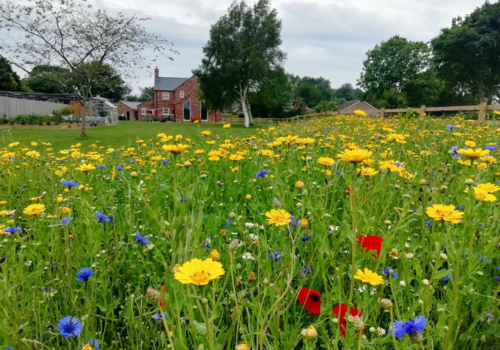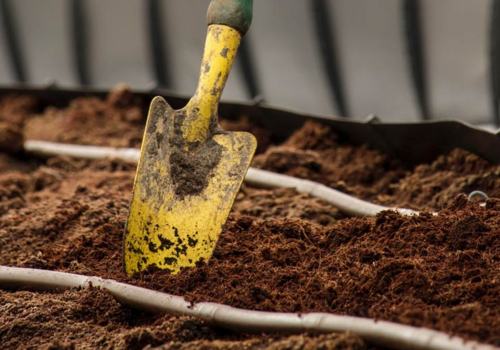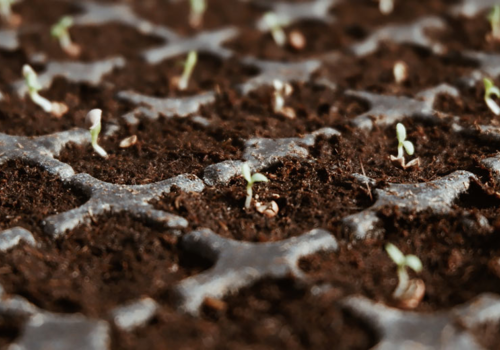Wildflowers are easy to care for once they’ve taken hold, but proper soil preparation is key to getting them established. Unlike many garden plants, wildflowers prefer low-nutrient soil, and sowing into the wrong conditions often leads to poor germination and weed problems. Whether you're working on a small garden border or a larger flower bed, starting with the right soil preparation can make all the difference.
This guide covers everything you need to know on how to prepare soil for wildflower seeds in UK conditions, including practical steps, soil type advice, and actionable tips for avoiding common mistakes.
Why Soil Preparation Matters for Wildflowers
Good soil preparation is the difference between a thriving wildflower patch and a disappointing one. Wildflowers have adapted to poor soils where there’s less competition from aggressive grasses and weeds. If the ground is too rich or left untouched, stronger plants will quickly outgrow the wildflowers which in turn reduces biodiversity.
Creating a clean, low-nutrient surface gives seeds better contact with the soil which is essential for germination. It also helps reduce early weed growth and while wildflower areas are often seen as low maintenance, they still need proper preparation at the start to succeed. Remember, natural doesn't necessarily mean no effort.
Choosing the Right Location
Wildflowers need plenty of sunlight to flourish, so be sure to pick a spot that gets at least six hours of sunlight a day. Shaded or damp areas will struggle to support most wildflower species and are more likely to encourage weeds or moss instead. Ideally, the area should be fairly open, free-draining, and not overly fertile.
Avoid heavily compacted ground or areas prone to waterlogging as these areas can limit seed germination and root development. Gentle slopes are fine but try to steer clear of steep or awkward spots that are difficult to access or maintain. Its best to think long-term too, so select an area which is manageable to ensure future care and maintenance is easier.
Understanding Your Soil Type (and How to Improve It)
Knowing your soil type helps you choose the right wildflower mix and allows for any small adjustments to be made before sowing. Most soils in the UK will support wildflowers with the right preparation, but a few tweaks can improve results depending on the conditions.
Clay Soil
Clay soils are heavy and slow draining which can make them tricky, especially in wetter months. If water tends to sit on the surface, consider adding coarse sand or grit to improve drainage. Avoid adding too much compost as the goal is to reduce fertility, not increase it.
Sandy Soil
Sandy soils drain quickly and warm up fast in spring, but they can become too dry for some species. A small amount of organic matter can help with water retention but don’t overdo it. Stick to drought-tolerant mixes suited to lighter soils.
Loamy Soil
Loam is the ideal balance of sand, silt, and clay. It drains well, holds enough moisture, and has a stable structure that’s perfect for wildflowers. You’ll still need to strip back fertility if it's been heavily managed, but it's the best starting point.
Chalky Soil
Chalky or alkaline soils can support wildflowers, but you’ll need to choose species that tolerate higher pH levels. Boston Seeds offers specific mixes for calcareous soils, making it easy to find the right fit.
Matching your seed mix to your soil type increases the chances of a successful meadow. It’s worth taking the time to understand what you’re working with before you start.
Step-by-Step Soil Preparation Process
Getting the soil right doesn’t need to be complicated, but each step plays a part in helping your wildflower seeds take hold. Follow this process carefully to give your flower beds the best possible start.
Clear the area
Start by removing any existing turf, weeds, or vegetation. If you’re working on lawn or pasture, the grass must be stripped completely as wildflower seeds won’t establish in competition with it.
Remove deep-rooted weeds
Use a fork or hoe to dig out perennial weeds like nettles, docks, and couch grass. These will come back quickly if left in the soil, so it’s important to be thorough.
Lightly cultivate the surface
Once the area is clear, rake or fork the top 2 to 3 centimetres of soil. You’re aiming for a fine, crumbly texture known as a tilth as this helps the seeds make good contact with the soil.
Firm the surface
After raking, tread the soil down gently with your boots or use a roller. This firms up any loose areas and helps create an even surface for sowing.
Don’t add fertiliser
It might seem counterintuitive, but wildflowers grow better in poor soil. Adding fertiliser will only encourage grasses and weeds and will make it harder for your flowers to establish.
Sow at the right time
In the UK, the best times to sow are in early spring (March to April) or late summer to early autumn (August to September). Avoid dry midsummer periods or frozen winter ground.
Common Mistakes to Avoid
A few common missteps can seriously affect how well your wildflower seeds grow. Avoiding these will save time and frustration later on.
Sowing into unprepared grass
This is one of the biggest causes of failure. Grass will quickly outcompete wildflowers, blocking light and stealing nutrients. Always clear the area first.
Over-cultivating the soil
Digging too deeply brings dormant weed seeds to the surface and increases fertility, both of which work against wildflowers. A light rake is all that’s needed.
Adding compost or fertiliser
Wildflowers don’t need rich soil. Fertiliser encourages aggressive plants, not the delicate species you want to grow. Resist the urge to enrich the soil.
Leaving perennial weeds
Nettles, docks, and couch grass can return fast and take over. Make sure these are fully removed before sowing.
Creating an uneven seedbed
If the surface is lumpy or patchy, seeds won’t settle evenly. Take time to level and firm the area to avoid bare patches and poor coverage.
Specific Advice for Larger Sites or Meadows
Preparing bigger areas like paddocks, field margins, or meadow strips follows roughly the same principles, but with a few extra considerations.
Use of machinery
For larger sites, using a harrow to lightly break up the surface and a roller to firm it afterwards can save time and improve results. Avoid deep ploughing, which raises soil fertility and brings up unwanted weeds.
Field margins and strips
If converting part of a field or garden, prepare narrow margins by removing vegetation and reducing soil fertility just as you would for a smaller area. These strips can be ideal for pollinators and are easier to manage.
Resting the land
Some sites benefit from being left fallow for a season or two, especially if heavily used or rich in nutrients. In some cases, subsoil exposed from construction or landscaping can make a better base for wildflowers than improved topsoil.
Weed suppression on a larger scale
Persistent weed problems over a big area can be tackled with tarping or temporary grazing. Covering the soil with a light-excluding sheet for several months will kill off existing growth without chemicals.
With larger meadows, a bit of planning goes a long way. Even on a bigger scale, the key points remain the same. Start with a clean, low-fertility ground and sow at the right time for the best possible results.
Aftercare: What to Do After Sowing
Once your seeds are sown, a few simple steps will help them settle in and start growing.
Press the seeds into the soil
Wildflower seeds need light to germinate, so don’t cover them with soil. Instead, walk over the area or use a roller to press them into the surface. This improves contact and reduces the chance of the seeds drying out or blowing away.
Avoid watering unless necessary
In most UK conditions, watering isn’t needed, especially if you’ve sown in autumn or early spring. Only water if there’s an extended dry spell and the soil starts to crack.
Watch for weeds in the first 6 weeks
Some weed growth is normal but keep an eye out for aggressive invaders. Remove them by hand before they get established but be careful not to disturb your seedlings.
Delay mowing until plants are established
In the first year, avoid mowing unless grass starts to really dominate. Most wildflowers won’t flower fully in year one, but they’re setting down roots. From the second year, follow a traditional meadow cut in late summer once the flowers have dropped their seed.
Frequently Asked Questions
Do I need to dig the soil before planting wildflowers?
No. Deep digging can bring up dormant weed seeds and increase fertility. Just rake the top 2–3cm to create a fine surface for sowing.
Can I just scatter wildflower seeds on the grass?
Not effectively. Grass will outcompete the seeds. You’ll need to remove the turf or heavily weaken the grass first.
Will wildflowers grow in very poor soil?
Yes. Wildflowers do best in low-nutrient soils, which help reduce competition from weeds and vigorous grasses.
Can I use a no-dig method with wildflowers?
It’s possible if you suppress existing vegetation with sheet mulch, like cardboard. But the top layer still needs raking to help the seeds make contact with the soil.


